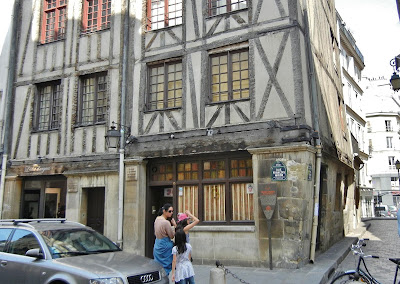The Arc de Triomphe is one of the most famous monuments in Paris. It stands in the center of Place Charles de Gaulle (also known as L'Etoile) at the western end of the Champs Elysées.
It was commissioned by Napoleon in 1806 because he was not satisfied with the much smaller, "
mesquin," Arc de Triomphe du Carrousel, which stands east of the Jardin des Tuileries. It honors all those who fought and died for France in the French Revolutionary and Napoleonic wars, with the names of all French victories and generals inscribed on its inner surfaces. There are four main sculptures on the outer sides of the columns,
Le Départ de 1792 (or
La Marseillaise),
Le Triomphe de 1810,
La Résistance de 1814, and
La Paix de 1815, shown here.
Napoleon was definitely exiled in 1815 and did not live to see the Arc de Triomphe completed. Its construction stopped during the Bourbon Restoration and it was finally unveiled in 1836 by the last king of France, Louis Philippe. But in 1840 Napoleon's remains did pass under it on their way from Saint Helena to his final resting place at the Invalides.
Beneath the Arc's vault lies the Tomb of the Unknown Soldier as well as the Eternal Flame, a flame of remembrance that commemorates the memory of the fallen soldiers and that's rekindled every evening at 6:30 PM by associations of veterans and victims of war.
This year was the 50th anniversary of the cease-fire that ended the war in Algiers. Even though the Government said there would be no national commemoration of the cease-fire, hundreds of veterans gathered as they do every year on March 19th at the National Memorial of the War of Algeria at Quai Branly and then marched up to the Arc de Triomphe and revived the flame on the tomb of the unknown soldier at 6:30.




All this was irrelevant to the kids, who just seemed to enjoy being able to play in the momentarily car-free streets around the Arc. We also enjoyed the view of the sun setting on La Defense, the business park west of Paris, where a new arch, the Grande Arche de La Défense, commissioned by French president François Mitterrand, was inaugurated in July 1989 with grand military parades that marked the bicentennial of the French Revolution. It completes the line of monuments that forms Paris's Axe Historique: the Arc de Triomphe du Carrousel, the Arc de Triomphe de l'Étoile, and now the Grande Arche de la Défense.




.jpg)












































